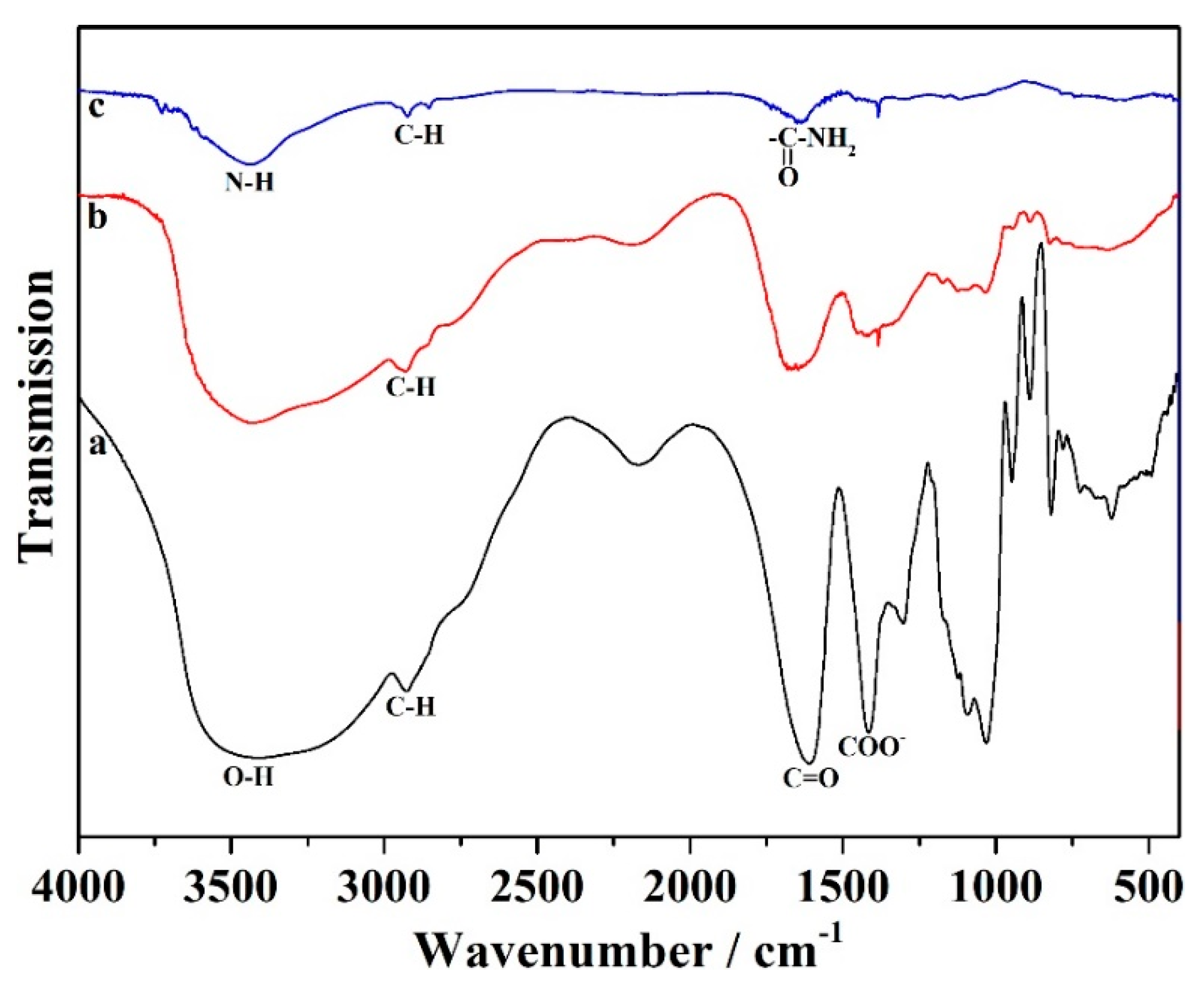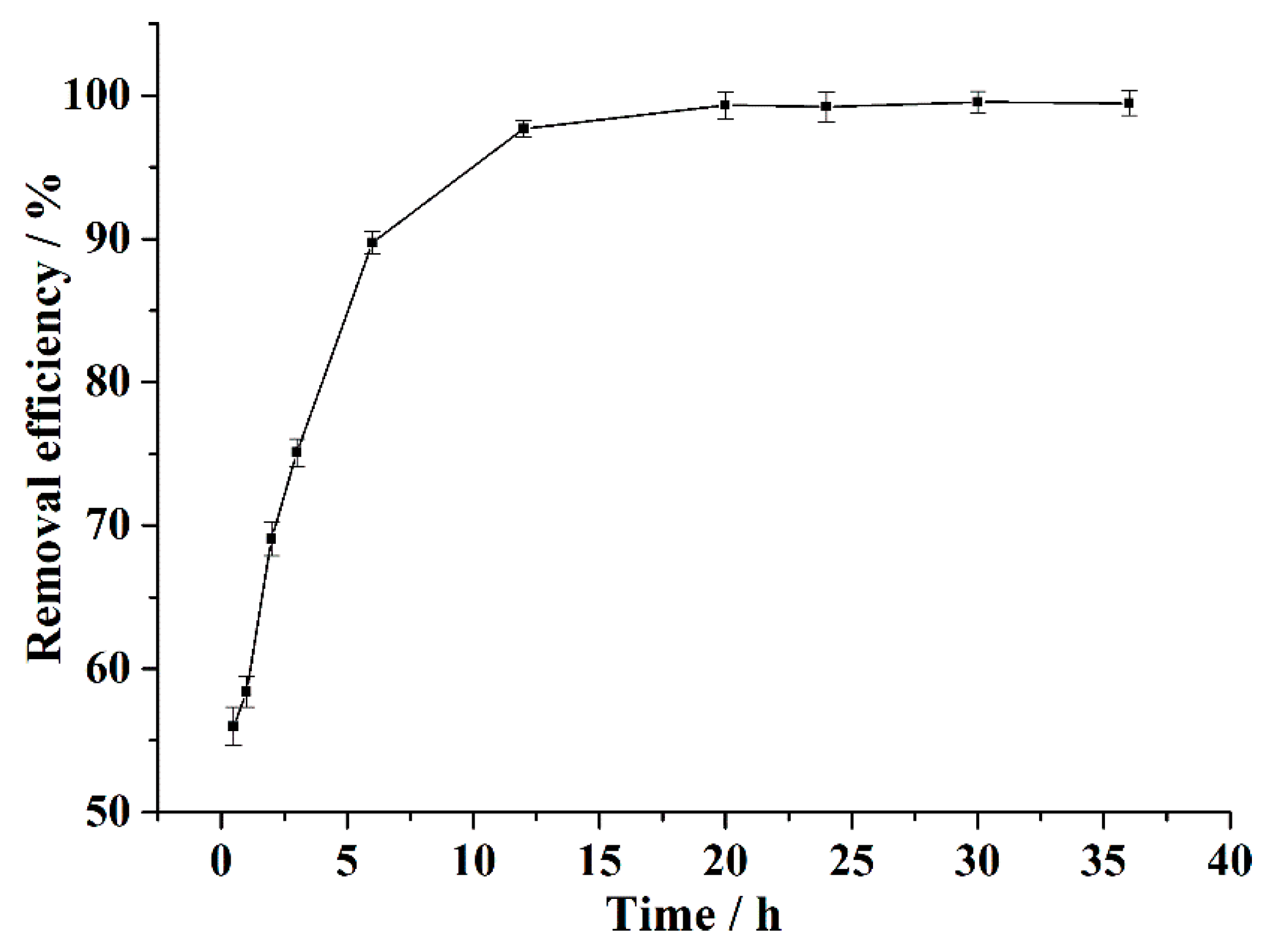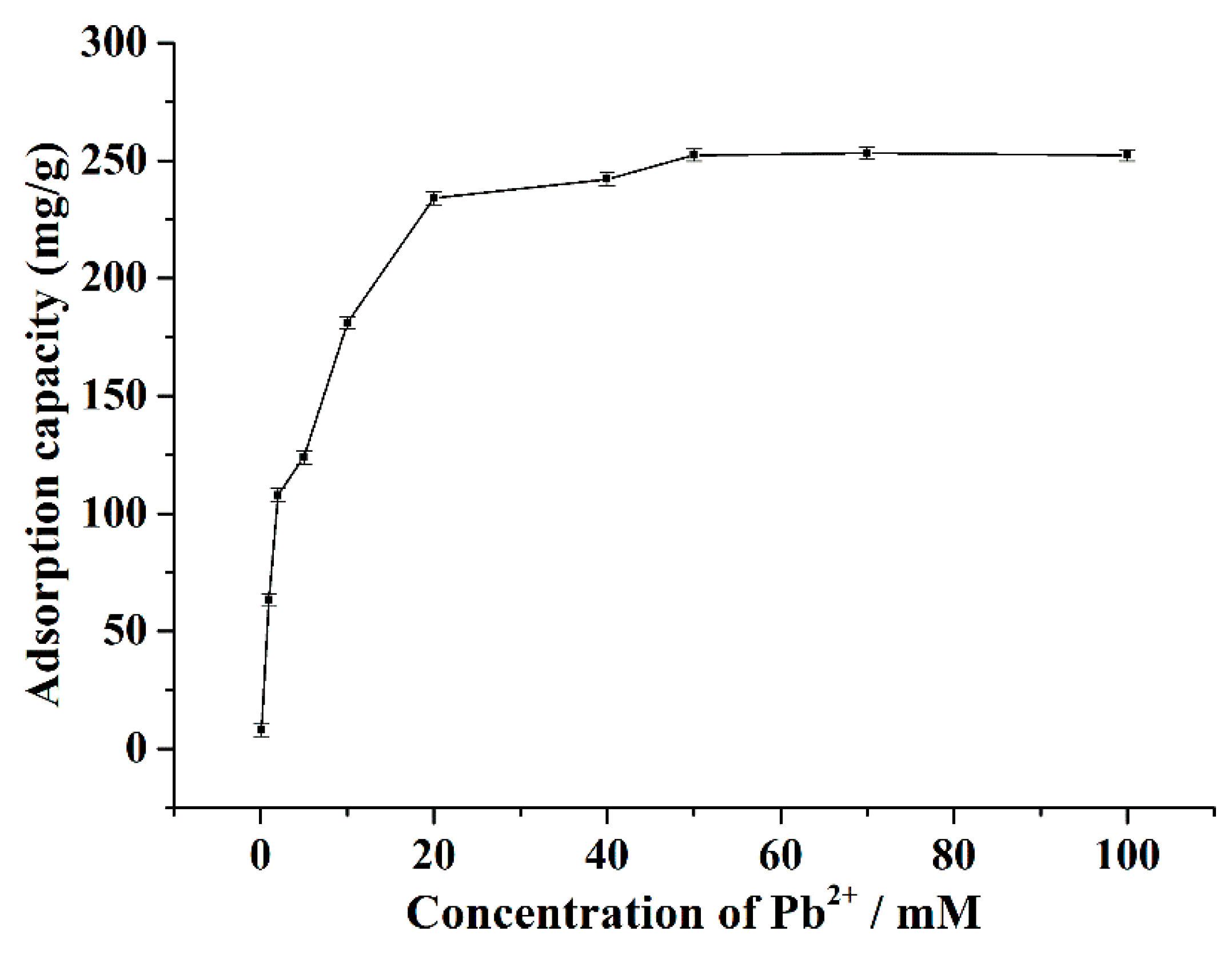Facile Fabrication of a Low-Cost Alginate-Polyacrylamide Composite Aerogel for the Highly Efficient Removal of Lead Ions
Abstract
:1. Introduction
2. Materials and Methods
2.1. Chemicals and Materials
2.2. Apparatus
2.3. Preparation of the Sodium Alginate-polyacrylamide (Alg–PAM) Composite Aerogel
2.4. Adsorption and Desorption Tests
3. Results and Discussion
3.1. Material Characterization
3.2. Effect of Solution pH
3.3. Effect of Adsorption Time
3.4. Influence of Temperature
3.5. Adsorption Performance of Alg–PAM for Metal Ions
3.6. Regeneration of Alg–PAM
4. Conclusions
Author Contributions
Funding
Conflicts of Interest
References
- Camizuli, E.; Scheifler, R.; Garnier, S.; Monna, F.; Losno, R.; Gourault, C.; Hamm, G.; Lachiche, C.; Delivet, G.; Chateau, C.; et al. Trace metals from historical mining sites and past metallurgical activity remain bioavailable to wildlife today. Sci. Rep. 2018, 8, 3436. [Google Scholar] [CrossRef]
- Hansson, S.V.; Grusson, Y.; Chimienti, M.; Claustres, A.; Jean, S.; Le Roux, G. Legacy Pb pollution in the contemporary environment and its potential bioavailability in three mountain catchments. Sci. Total Environ. 2019, 671, 1227–1236. [Google Scholar] [CrossRef]
- Wang, Z.Q.; Wu, A.G.; Ciacchi, L.C.; Wei, G. Recent advances in nanoporous membranes for water purification. Nanomaterials 2018, 8, 65. [Google Scholar] [CrossRef]
- Cundy, A.B.; Croudace, I.W. The fate of contaminants and stable Pb isotopes in a changing estuarine environment: 20 years on. Environ. Sci. Technol. 2017, 51, 9488–9497. [Google Scholar] [CrossRef]
- Li, K.T.; Wu, G.H.; Wang, M.; Zhou, X.H.; Wang, Z.Q. Efficient removal of lead ions from water by a low-cost alginate-melamine hybrid sorbent. Appl. Sci. 2018, 8, 1518. [Google Scholar] [CrossRef]
- Li, Y.; Qiu, T.B.; Xu, X.Y. Preparation of lead-ion imprinted crosslinked electro-spun chitosan nanofiber mats and application in lead ions removal from aqueous solutions. Eur. Polym. J. 2013, 49, 1487–1494. [Google Scholar] [CrossRef]
- Chakraborty, A.; Deva, D.; Sharma, A.; Verma, N. Adsorbents based on carbon microfibers and carbon nanofibers for the removal of phenol and lead from water. J. Colloid Interf. Sci. 2011, 359, 228–239. [Google Scholar] [CrossRef]
- Tao, Y.G.; Ye, L.B.; Pan, J.; Wang, Y.M.; Tang, B. Removal of Pb(II) from aqueous solution on chitosan/TiO2 hybrid film. J. Hazard. Mater. 2009, 161, 718–722. [Google Scholar] [CrossRef]
- Han, Y.; Xu, Z.; Gao, C. Ultrathin graphene nanofiltration membrane for water purification. Adv. Funct. Mater. 2013, 23, 3693–3700. [Google Scholar] [CrossRef]
- Ragnini, C.A.R.; Di Iglia, R.A.; Bizzo, W.; Bertazzoli, R. Recycled niobium felt as an efficient three-dimensional electrode for electrolytic metal ion removal. Water Res. 2000, 34, 3269–3276. [Google Scholar] [CrossRef]
- Gao, F.F.; Du, X.; Hao, X.G.; Li, S.S.; Zheng, J.L.; Yang, Y.Y.; Han, N.C.; Guan, G.Q. A potential-controlled ion pump based on a three-dimensional PPy@GO membrane for separating dilute lead ions from wastewater. Electrochim. Acta 2017, 236, 434–442. [Google Scholar] [CrossRef]
- Wang, Y.; Guo, L.; Qi, P.F.; Liu, X.M.; Wei, G. Synthesis of three-dimensional graphene-based hybrid materials for water purification: A review. Nanomaterials 2019, 9, 1123. [Google Scholar] [CrossRef]
- Abdel-Halim, S.H.; Shehata, A.M.A.; El-Shahat, M.F. Removal of lead ions from industrial waste water by different types of natural materials. Water Res. 2003, 37, 1678–1683. [Google Scholar] [CrossRef]
- Klapiszewski, L.; Bartczak, P.; Wysokowski, M.; Jankowska, M.; Kabat, K.; Jesionowski, T. Silica conjugated with kraft lignin and its use as a novel ‘green’ sorbent for hazardous metal ions removal. Chem. Eng. J. 2015, 260, 684–693. [Google Scholar] [CrossRef]
- Fang, R.; Tian, W.M.; Chen, X.B.A. Synthesis of injectable alginate hydrogels with muscle-derived stem cells for potential myocardial infarction repair. Appl. Sci. 2017, 7, 252. [Google Scholar] [CrossRef]
- Lakouraj, M.M.; Mojerlou, F.; Zare, E.N. Nanogel and superparamagnetic nanocomposite based on sodium alginate for sorption of heavy metal ions. Carbohydr. Polym. 2014, 106, 34–41. [Google Scholar] [CrossRef]
- Wang, Z.Q.; Huang, Y.G.; Wang, M.; Wu, G.H.; Geng, T.M.; Zhao, Y.G.; Wu, A.G. Macroporous calcium alginate aerogel as sorbent for Pb2+ removal from water media. J. Environ. Chem. Eng. 2016, 4, 3185–3192. [Google Scholar] [CrossRef]
- Godiya, C.B.; Cheng, X.; Li, D.W.; Chen, Z.; Lu, X.L. Carboxymethyl cellulose/polyacrylamide composite hydrogel for cascaded treatment/reuse of heavy metal ions in wastewater. J. Hazard. Mater. 2019, 364, 28–38. [Google Scholar] [CrossRef]
- Moreno-Sader, K.; Garcia-Padilla, A.; Realpe, A.; Acevedo-Morantes, M.; Soares, J.B.P. Removal of heavy metal water pollutants (Co2+ and Ni2+) using polyacrylamide/sodium montmorillonite (pam/na-mmt) nanocomposites. ACS Omega 2019, 4, 10834–10844. [Google Scholar] [CrossRef]
- Park, H.G.; Kim, T.W.; Chae, M.Y.; Yoo, I.K. Activated carbon-containing alginate adsorbent for the simultaneous removal of heavy metals and toxic organics. Process Biochem. 2007, 42, 1371–1377. [Google Scholar] [CrossRef]
- Unnithan, M.R.; Vinod, V.P.; Anirudhan, T.S. Synthesis, characterization, and application as a chromium(VI) adsorbent of amine-modified polyacrylamide-grafted coconut coir pith. Ind. Eng. Chem. Res. 2004, 43, 2247–2255. [Google Scholar] [CrossRef]
- Pan, L.H.; Wang, Z.Q.; Zhao, X.Q.; He, H.Y. Efficient removal of lead and copper ions from water by enhanced strength-toughness alginate composite fibers. Int. J. Biol. Macromol. 2019, 134, 223–229. [Google Scholar] [CrossRef] [PubMed]
- Wang, Z.Q.; Jin, P.X.; Wang, M.; Wu, G.H.; Sun, J.Y.; Zhang, Y.J.; Dong, C.; Wu, A.G. Highly efficient removal of toxic Pb2+ from wastewater by an alginate-chitosan hybrid adsorbent. J. Chem. Technol. Biotechnol. 2018, 93, 2691–2700. [Google Scholar] [CrossRef]
- Yang, J.; Wu, J.X.; Lu, Q.F.; Lin, T.T. Facile preparation of lignosulfonate-graphene oxide-polyaniline ternary nanocomposite as an effective adsorbent for Pb(II) ions. ACS Sustain. Chem. Eng. 2014, 2, 1203–1211. [Google Scholar] [CrossRef]
- Sprynskyy, M.; Buszewski, B.; Terzyk, A.P.; Namiesnik, J. Study of the selection mechanism of heavy metal (Pb2+, Cu2+, Ni2+, and Cd2+) adsorption on clinoptilolite. J. Colloid Interf. Sci. 2006, 304, 21–28. [Google Scholar] [CrossRef]
- Sharma, P.; Singh, A.K.; Shahi, V.K. Selective adsorption of Pb(II) from aqueous medium by cross-linked chitosan-functionalized graphene oxide adsorbent. ACS Sustain. Chem. Eng. 2019, 7, 1427–1436. [Google Scholar] [CrossRef]
- Wang, C.P.; Wu, J.Z.; Sun, H.W.; Wang, T.; Liu, H.B.; Chang, Y. Adsorption of Pb(II) ion from aqueous solutions by tourmaline as a novel adsorbent. Ind. Eng. Chem. Res. 2011, 50, 8515–8523. [Google Scholar] [CrossRef]
- Zhou, G.Y.; Luo, J.M.; Liu, C.B.; Chu, L.; Ma, J.H.; Tang, Y.H.; Zeng, Z.B.; Luo, S.L. A highly efficient polyampholyte hydrogel sorbent based fixed-bed process for heavy metal removal in actual industrial effluent. Water Res. 2016, 89, 151–160. [Google Scholar] [CrossRef]
- Googerdchian, F.; Moheb, A.; Emadi, R.; Asgari, M. Optimization of Pb(II) ions adsorption on nanohydroxyapatite adsorbents by applying taguchi method. J. Hazard. Mater. 2018, 349, 186–194. [Google Scholar] [CrossRef]
- Rathour, R.K.S.; Bhattacharya, J.; Mukherjee, A. Facile synthesis of graphene oxide for multicycle adsorption of aqueous Pb2+ in the presence of divalent cations and polyatomic anions. J. Chem. Eng. Data 2018, 63, 3465–3474. [Google Scholar] [CrossRef]
- Sheshmani, S.; Nematzadeh, M.A.; Shokrollahzadeh, S.; Ashori, A. Preparation of graphene oxide/chitosan/FeOOH nanocomposite for the removal of Pb(II) from aqueous solution. Int. J. Biol. Macromol. 2015, 80, 475–480. [Google Scholar] [CrossRef]
- Yari, M.; Norouzi, M.; Mahvi, A.H.; Rajabi, M.; Yari, A.; Moradi, O.; Tyagi, I.; Gupta, V.K. Removal of Pb(II) ion from aqueous solution by graphene oxide and functionalized graphene oxide-thiol: Effect of cysteamine concentration on the bonding constant. Desalin. Water Treat. 2016, 57, 11195–11210. [Google Scholar] [CrossRef]
- Gao, T.T.; Yu, J.G.; Zhou, Y.; Jiang, X.Y. The synthesis of graphene oxide functionalized with dithiocarbamate group and its prominent performance on adsorption of lead ions. J. Taiwan Inst. Chem. E 2017, 71, 426–432. [Google Scholar] [CrossRef]
- Wang, N.N.; Xu, X.J.; Li, H.Y.; Zhai, J.L.; Yuan, L.Z.; Zhang, K.X.; Yu, H.W. Preparation and application of a xanthate-modified thiourea chitosan sponge for the removal of Pb(II) from aqueous solutions. Ind. Eng. Chem. Res. 2016, 55, 4960–4968. [Google Scholar] [CrossRef]
- Wang, H.Y.; Gao, B.; Wang, S.S.; Fang, J.; Xue, Y.W.; Yang, K. Removal of Pb(II), Cu(II), and Cd(II) from aqueous solutions by biochar derived from KMnO4 treated hickory wood. Bioresour. Technol. 2015, 197, 356–362. [Google Scholar] [CrossRef] [PubMed]
- Tan, Y.; Wang, K.L.; Yan, Q.; Zhang, S.F.; Li, J.Z.; Ji, Y. Synthesis of amino-functionalized waste wood flour adsorbent for high-capacity Pb(II) adsorption. ACS Omega 2019, 4, 10475–10484. [Google Scholar] [CrossRef] [PubMed]
- Huang, X.M.; Pan, M. The highly efficient adsorption of Pb(II) on graphene oxides: A process combined by batch experiments and modeling techniques. J. Mol. Liq. 2016, 215, 410–416. [Google Scholar] [CrossRef]
- Medina, R.P.; Nadres, E.T.; Ballesteros, F.C.; Rodrigues, D.F. Incorporation of graphene oxide into a chitosan-poly(acrylic acid) porous polymer nanocomposite for enhanced lead adsorption. Environ. Sci-Nano 2016, 3, 638–646. [Google Scholar] [CrossRef]
- Mahfooz-ur-Rehman; Rehman, W.; Waseem, M.; Shah, B.A.; Shakeel, M.; Haq, S.; Zaman, U.; Bibi, I.; Khan, H.D. Fabrication of titanium-tin oxide nanocomposite with enhanced adsorption and antimicrobial applications. J. Chem. Eng. Data 2019, 64, 2436–2444. [Google Scholar] [CrossRef]
- Kundu, S.; Chowdhury, I.H.; Naskar, M.K. Nitrogen-doped nanoporous carbon nanospheroids for selective dye adsorption and Pb(II) ion removal from waste water. ACS Omega 2018, 3, 9888–9898. [Google Scholar] [CrossRef]
- Jin, C.; Zhang, X.Y.; Xin, J.N.; Liu, G.F.; Chen, J.; Wu, G.M.; Liu, T.; Zhang, J.W.; Kong, Z.W. Thiol-ene synthesis of cysteine-functionalized lignin for the enhanced adsorption of Cu(II) and Pb(II). Ind. Eng. Chem. Res. 2018, 57, 7872–7880. [Google Scholar] [CrossRef]
- Bayramoglu, G.; Arica, M.Y. Mcm-41 silica particles grafted with polyacrylonitrile: Modification in to amidoxime and carboxyl groups for enhanced uranium removal from aqueous medium. Microporous Mesoporous Mater. 2016, 226, 117–124. [Google Scholar] [CrossRef]








| Alg–PAM | Initial Solution (mM) | Removal Efficiency (%) | Adsorption Capacity (mg/g) | Kd | k | ||||
|---|---|---|---|---|---|---|---|---|---|
| In ultrapure water | 0.1 (Pb2+) | - | 99.2 | - | 8.2 | - | 49.6 | - | - |
| 0.1 (Cu2+) | - | 91.6 | - | 2.3 | - | 4.4 | - | - | |
| 0.1 (Cr3+) | - | 92.4 | - | 1.9 | - | 4.9 | - | - | |
| 0.1 (Cd2+) | - | 90.2 | - | 4.1 | - | 3.7 | - | - | |
| 0.1 (Zn2+) | - | 76.9 | - | 2.0 | - | 1.3 | - | - | |
| 0.1 (Co2+) | - | 69.5 | - | 1.6 | - | 0.9 | - | - | |
| 0.1 (Pb2+) | 0.1 (Cu2+) | 95.3 | 71.8 | 7.9 | 1.8 | 8.1 | 1.0 | 8.0 | |
| 0.1 (Pb2+) | 0.1 (Cr3+) | 96.5 | 67.7 | 8.0 | 1.4 | 11.0 | 0.8 | 13.2 | |
| 0.1 (Pb2+) | 0.1 (Cd2+) | 96.7 | 66.0 | 8.0 | 3.0 | 11.7 | 0.8 | 15.1 | |
| 0.1 (Pb2+) | 0.1 (Zn2+) | 97.8 | 61.9 | 8.1 | 1.6 | 17.8 | 0.6 | 27.3 | |
| 0.1 (Pb2+) | 0.1 (Co2+) | 97.1 | 43.2 | 8.0 | 1.0 | 13.4 | 0.3 | 44.0 | |
| In lake water | 0.1 (Pb2+) | - | 88.4 | - | 7.3 | - | 3.1 | - | - |
| In river water | 0.1 (Pb2+) | - | 94.3 | - | 7.8 | - | 6.6 | - | - |
| Adsorbents | Adsorbate | Maximum Adsorption Capacity (mg/g) | References |
|---|---|---|---|
| Polyampholyte hydrogel | Pb2+, Cd2+ | 216.1(Pb2+), 153.8(Cd2+) | [28] |
| Nanohydroxyapatite | Pb2+ | 200.0 | [29] |
| GO 1 | Pb2+ | 178.5 | [30] |
| GO/chitosan/FeOOH | Pb2+ | 111.1 | [31] |
| Thiol-functionalized GO | Pb2+ | 200.0 | [32] |
| Dithiocarbamate-functionalized GO | Pb2+ | 132.0 | [33] |
| Xanthate-modified thiourea chitosan sponge | Pb2+ | 188.1 | [34] |
| Biochar | Pb2+, Cd2+, Cu2+ | 153.1(Pb2+), 28.1(Cd2+), 34.2(Cu2+) | [35] |
| Amino-functionalized wood flour | Pb2+ | 189.9 | [36] |
| GO | Pb2+ | 125.0 | [37] |
| Chitosan-poly(acrylic acid) composite beads | Pb2+ | 138.9 | [38] |
| Titanium-Tin oxide nanocomposite | Pb2+ | 70.0 | [39] |
| Nitrogen-doped carbon nanospheroids | Pb2+ | 99.8 | [40] |
| Cysteine-functionalized lignin | Pb2+, Cu2+ | 55.5(Pb2+), 68.7(Cu2+) | [41] |
| Alg–PAM 2 | Pb2+ | 252.2 | Our work |
© 2019 by the authors. Licensee MDPI, Basel, Switzerland. This article is an open access article distributed under the terms and conditions of the Creative Commons Attribution (CC BY) license (http://creativecommons.org/licenses/by/4.0/).
Share and Cite
Wang, Z.; Yang, Q.; Zhao, X.; Wei, G. Facile Fabrication of a Low-Cost Alginate-Polyacrylamide Composite Aerogel for the Highly Efficient Removal of Lead Ions. Appl. Sci. 2019, 9, 4754. https://doi.org/10.3390/app9224754
Wang Z, Yang Q, Zhao X, Wei G. Facile Fabrication of a Low-Cost Alginate-Polyacrylamide Composite Aerogel for the Highly Efficient Removal of Lead Ions. Applied Sciences. 2019; 9(22):4754. https://doi.org/10.3390/app9224754
Chicago/Turabian StyleWang, Zhuqing, Qi Yang, Xiuqin Zhao, and Gang Wei. 2019. "Facile Fabrication of a Low-Cost Alginate-Polyacrylamide Composite Aerogel for the Highly Efficient Removal of Lead Ions" Applied Sciences 9, no. 22: 4754. https://doi.org/10.3390/app9224754
APA StyleWang, Z., Yang, Q., Zhao, X., & Wei, G. (2019). Facile Fabrication of a Low-Cost Alginate-Polyacrylamide Composite Aerogel for the Highly Efficient Removal of Lead Ions. Applied Sciences, 9(22), 4754. https://doi.org/10.3390/app9224754






